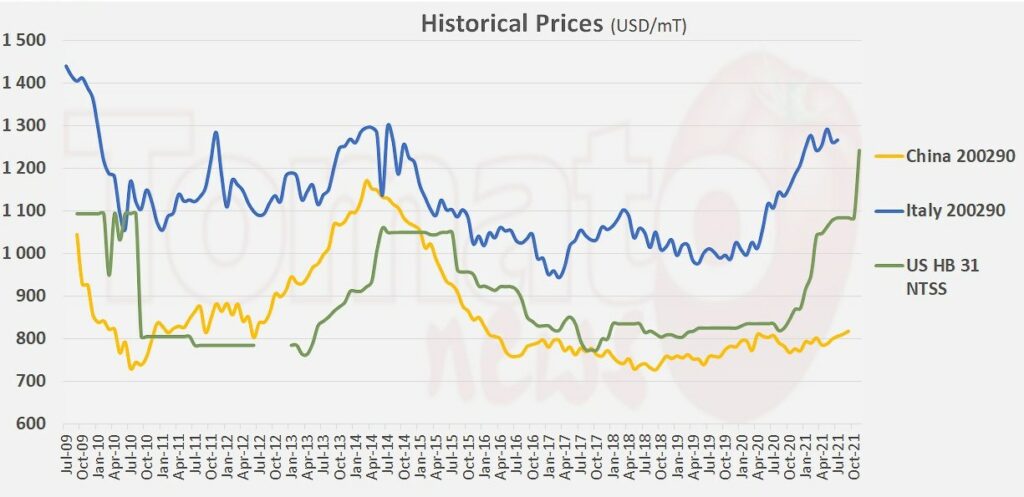2021 Global production 0.9% higher than 2020 at 38.7 Million mT

The most notable changes in production were in the AMITOM region, where production increased by 8%, and in the European Union, up 16%. California had an uncharacteristic decrease by 6% in total production as well as China, producing 17% less than in 2020.
As mentioned, the AMITOM region saw a boost in production, with countries like Italy and Spain carrying the bulk of the AMITOM production in their regions. Despite facing higher prices for raw materials and only a 40% water allocation in Andalusia, Spain estimates that 3.185 million tonnes of tomatoes were processed with average yields of 93 tonnes per hectare. While raw materials increased by 11% on average, more fields were planted, and Spain enjoyed good weather with high yields and good quality.
Italy’s production was higher than initial intentions, manufacturing 6.05 million tonnes, an increase that can be attributed to a strong season in Northern Italy. Average yields were 80 tonnes/hectare. Southern Italy recovered from a difficult 2020 crop and had average yields of 90.87 tonnes/hectare.
Portugal’s official figures were not officially available, but it is estimated to have produced 1.596 million tonnes with average yields of 103 tonnes per hectare. Benefitting from a good weather year without setbacks, Portugal finished the season with a nice crop of good quality and color. The average brix was 5.1.
Tunisia increased its total planting surface this season to 17,000 hectares. Unfortunately, due to a heatwave, yields decreased 15% and total production came in at 1.1 million mT. Weather also adversely affected Greece, where transplants were lost in April because of frost. Additionally, late-season heatwaves caused problems, and the country produced 9% less than expected and finished with 420,000 mT.
Again, weather accounted for France’s reduced tonnage, with final figures of 164,000 tonnes due to cold and wet conditions. While planted surfaces were increased from 2,217 hectares to 2,559 hectares (and organic surfaces from 392 to 566), weather curtailed France’s ability to take advantage of the increased planting area.
In China, the price of tomatoes saw an increase by 10 to 15%; therefore, raw materials were reduced by one million tonnes. Weather was adequate, but due to the harvesting of premature fields as processors attempted to get raw material, quality suffered. The total volume in China was 4.8 million mT.
Argentina experienced a banner year in terms of total tonnage and yields. With 594,572 tonnes produced, yields of 110 tonnes/hectare were achieved. 2021 will serve as Argentina’s record-breaking year, as the country has never produced this volume of product in its history. With more sophisticated field technologies and good climate conditions, Argentina looks to continue its climb, estimating to increase planting up to 7% in 2022.
Global prices continue to increase, with the most notable being the United States and Italy. The U.S. has faced increased prices in raw material and, coupled with competition from permanent crops and severe water restrictions, must incorporate those costs in their price of paste. As we see a rise in raw material costs worldwide, we should expect rising prices to reflect those increased costs.
###

Morning Star Newsletter now distributed electronically
As a reminder, Morning Star is now distributing our newsletters electronically using an email distribution vendor called Mailchimp. Your e-version will now include informative Morning Star videos and highlights. Depending on your company's firewall, these emails may initially be directed to you spam folder.


